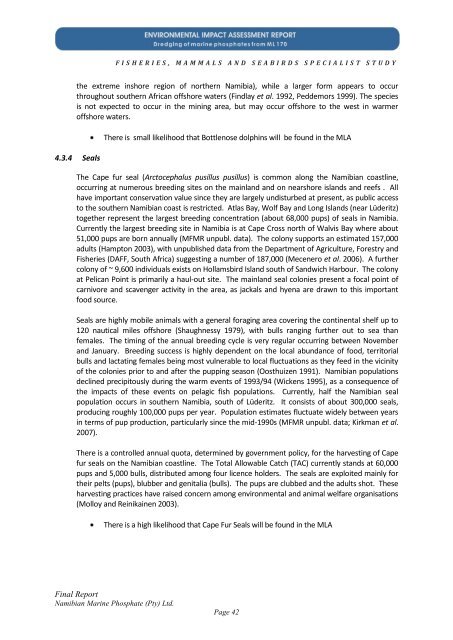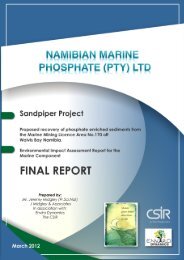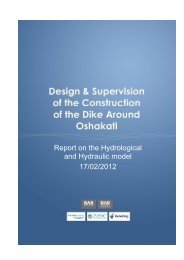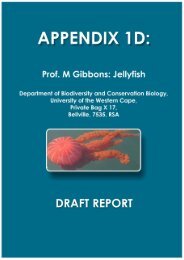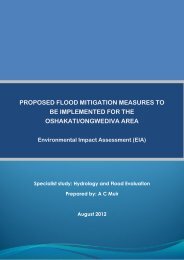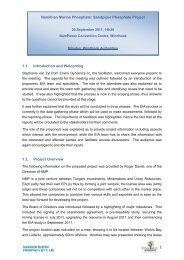Fisheries - Enviro Dynamics Namibia
Fisheries - Enviro Dynamics Namibia
Fisheries - Enviro Dynamics Namibia
Create successful ePaper yourself
Turn your PDF publications into a flip-book with our unique Google optimized e-Paper software.
F I S H E R I E S , M A M M A L S A N D S E A B I R D S S P E C I A L I S T S T U D Y<br />
the extreme inshore region of northern <strong>Namibia</strong>), while a larger form appears to occur<br />
throughout southern African offshore waters (Findlay et al. 1992, Peddemors 1999). The species<br />
is not expected to occur in the mining area, but may occur offshore to the west in warmer<br />
offshore waters.<br />
4.3.4 Seals<br />
There is small likelihood that Bottlenose dolphins will be found in the MLA<br />
The Cape fur seal (Arctocephalus pusillus pusillus) is common along the <strong>Namibia</strong>n coastline,<br />
occurring at numerous breeding sites on the mainland and on nearshore islands and reefs . All<br />
have important conservation value since they are largely undisturbed at present, as public access<br />
to the southern <strong>Namibia</strong>n coast is restricted. Atlas Bay, Wolf Bay and Long Islands (near Lüderitz)<br />
together represent the largest breeding concentration (about 68,000 pups) of seals in <strong>Namibia</strong>.<br />
Currently the largest breeding site in <strong>Namibia</strong> is at Cape Cross north of Walvis Bay where about<br />
51,000 pups are born annually (MFMR unpubl. data). The colony supports an estimated 157,000<br />
adults (Hampton 2003), with unpublished data from the Department of Agriculture, Forestry and<br />
<strong>Fisheries</strong> (DAFF, South Africa) suggesting a number of 187,000 (Mecenero et al. 2006). A further<br />
colony of ~ 9,600 individuals exists on Hollamsbird Island south of Sandwich Harbour. The colony<br />
at Pelican Point is primarily a haul-out site. The mainland seal colonies present a focal point of<br />
carnivore and scavenger activity in the area, as jackals and hyena are drawn to this important<br />
food source.<br />
Seals are highly mobile animals with a general foraging area covering the continental shelf up to<br />
120 nautical miles offshore (Shaughnessy 1979), with bulls ranging further out to sea than<br />
females. The timing of the annual breeding cycle is very regular occurring between November<br />
and January. Breeding success is highly dependent on the local abundance of food, territorial<br />
bulls and lactating females being most vulnerable to local fluctuations as they feed in the vicinity<br />
of the colonies prior to and after the pupping season (Oosthuizen 1991). <strong>Namibia</strong>n populations<br />
declined precipitously during the warm events of 1993/94 (Wickens 1995), as a consequence of<br />
the impacts of these events on pelagic fish populations. Currently, half the <strong>Namibia</strong>n seal<br />
population occurs in southern <strong>Namibia</strong>, south of Lüderitz. It consists of about 300,000 seals,<br />
producing roughly 100,000 pups per year. Population estimates fluctuate widely between years<br />
in terms of pup production, particularly since the mid-1990s (MFMR unpubl. data; Kirkman et al.<br />
2007).<br />
There is a controlled annual quota, determined by government policy, for the harvesting of Cape<br />
fur seals on the <strong>Namibia</strong>n coastline. The Total Allowable Catch (TAC) currently stands at 60,000<br />
pups and 5,000 bulls, distributed among four licence holders. The seals are exploited mainly for<br />
their pelts (pups), blubber and genitalia (bulls). The pups are clubbed and the adults shot. These<br />
harvesting practices have raised concern among environmental and animal welfare organisations<br />
(Molloy and Reinikainen 2003).<br />
There is a high likelihood that Cape Fur Seals will be found in the MLA<br />
Final Report<br />
<strong>Namibia</strong>n Marine Phosphate (Pty) Ltd.<br />
Page 42


